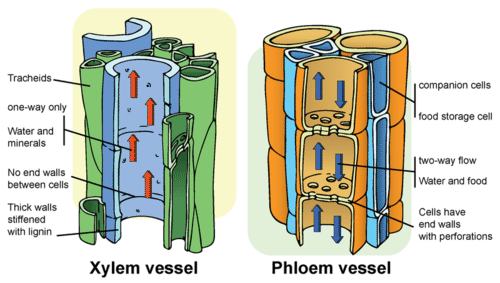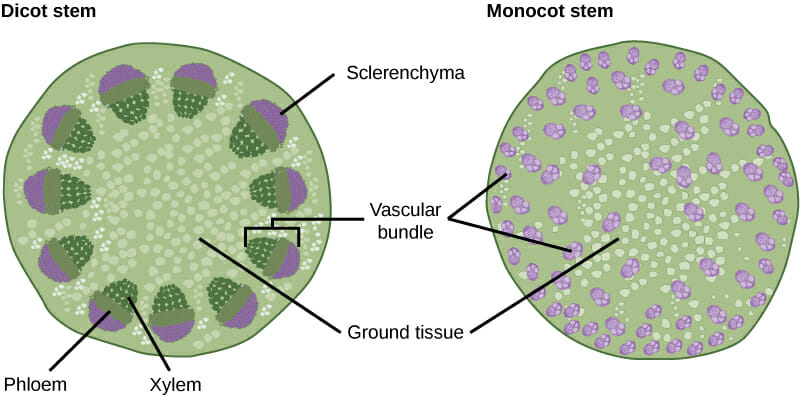Describe the Vascular System of a Typical Plant
Both are illustrated in the image below. 2 What are the component parts of the root system and shoot system of typical flowering plant such as tomato.

Vascular Plants Ck 12 Foundation
The two types of vascular tissue xylem and phloem are responsible for moving water minerals and the products of photosynthesis throughout the plant.

. 2 absorb and conduct water minerals and nutrients to the other systems. In addition the vascular system serves as an effective long-distance communication. There is one main vein that has smaller veins branching off sideways from i Sap A sugar-rich liquid transported by phloem Starch Chemicals produced by plants to store food.
Xylem The xylem is a tissue that supplies water throughout the parts of the plant. Which of the following describes the vascular system of a typical plant. Vascular bundle The group of xylem tubes and phloem tubes in a vascular plant.
There are two kinds of vascular tissue system in plants and they are called Phloem and Xylem. The shoot system consists of two portions. The pericycle is the outermost layer of the stele and consists of one or more rows of thin-walled meristematic parenchyma cells.
The three vegetative organs ie stem root and leaf are distinguished by the relative distribution of the vascular and ground tissues. Which of the following is the waxy coating secreted on leaves and most stems. 1 After studying and reviewing the diagrams and pictures on pages 763 to 784 describe the components and functions of internal plant vascular tissue as on pages 770-772.
- It is made up of xylem and phloem. - It provides support. As opposed to a non-vascular plant a vascular plant can grow much larger.
The vegetative non-reproductive parts of the plant such as the leaves and the stems and the reproductive parts of the plant which include flowers and fruits. - It transports nutrients throughout the plant. Describe the Organization of the Vascular Plant Body.
2 OB Chapter 22 - Infant Feeding 33 Terms. The two primary vascular tissues are xylem which transports water and dissolved minerals from the roots to the leaves and phloem which conducts food from the leaves to all parts of the plant. It is made up of xylem and phloem.
The plant vascular system carries out two essential functions namely the delivery of resources water essential mineral nutrients sugars and amino acids to the various plant organs and provision of mechanical support. It anchors the plant in the ground and transport minerals and water into the plant. The stem is responsible for elongation of the plant and acts as a central axis for other organs to attach to.
The stele or vascular cylinder responsible for transporting water and minerals consists of the pericycle phloem cambium and xylem. A shoot system and a root system. Major Vessels-Supply and Drain-Biol 242 Saps Students 68 Terms.
The three basic organs of a vascular plant are the stems leaves and roots. The shoot system generally grows above ground where it. Which of the following describes the vascular system of a typical plant.
Sugar The nutrient that cells use for energy. The plant vascular system is a complicated network of conducting tissues that interconnects all organs and transports water minerals nutrients organic compounds and various signaling molecules throughout the plant body. Roots The stem of the plant is behind the derivation of the roots which are the group of simple tissues.
1 The dermal 2 The vascular and 3 The fundamental or ground system. Vascular system in vascular plants assemblage of conducting tissues and associated supportive fibres that transport nutrients and fluids throughout the plant body. The stems consist of nodes where leaves attach and internodes between the nodes.
A vascular plant is any one of a number of plants with specialized vascular tissue. The vascular tissue system in plants to which these plants are known are designed to transport fluid and they are made up of narrow long cells laid out end-to-end making tubes. A leaf vein pattern that looks like a feather.
And 3 store energy. It is in close contact with the xylem and phloem tissues of the root. The root system supports the plant and is usually underground.
Vascular System Lecture 76 Terms. Vascular plants have two distinct organ systems. A typical plant body consists of two distinct systems.
The shoot system and the root system. A vascular plant consists of two organ systems. Chapter 4- Muscular System 46 Terms.
Biology questions and answers. The shoot system consists stems leaves and the reproductive parts of the plant flowers and fruits. The shoot system includes the aboveground vegetative portions stems and leaves and reproductive parts flowers and fruits.
Describe the vascular system of a typical plant It is made up of xylem and phloem transports nutrients throughout the plant and provides support TF The main function of roots is to anchor plants in the soil. With the help of xylem and phloem present in the tree vascular tissuesphloem is the innermost layer of the bark structuremultiple cross sections of a. As pointed out by Sachs 1875 the plant body of a vascular plant is composed of three systems of tissues.
It transports nutrients throughout the plant. The root system is usually below the ground and functions to 1 anchor and support the plant. Characteristics of Vascular Plants 1.
The shoot system generally grows above ground where it absorbs the light needed for. A shoot system and a root system. Vascular plants have two distinct organ systems.
A root system and a shoot system. It is composed of two major tissues xylem and phloem that are differentiated from the meristemic tissue procambium.

Vascular Plant Definition Examples Structure Biology Dictionary

Vascular Plant Definition Examples Structure Biology Dictionary

No comments for "Describe the Vascular System of a Typical Plant"
Post a Comment